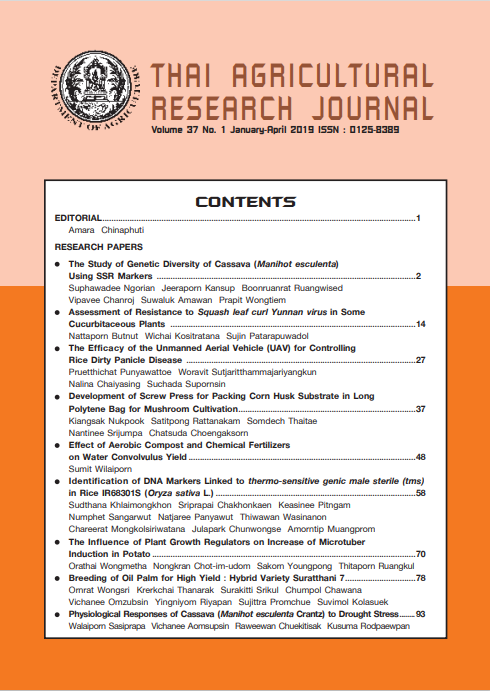The Efficacy of the Unmanned Aerial Vehicle (UAV) for Controlling Rice Dirty Panicle Disease
DOI:
https://doi.org/10.14456/thaidoa-agres.2019.4Keywords:
Unmanned aerial application, dirty panicle disease, spray deposition, spray drift deposition, operator exposure.Abstract
The efficacy of UAV for controlling dirty panicle disease in paddy field was investigated in Suphanburi province from August 2017 to October 2017. Field studies were conducted using the colorimetric method on two different rice growth stages: heading stage (74 days after sowing) and flowering stage (91 days after sowing). Spray deposition and spray drift deposition on the ground under actual working conditions were studied and compared with normal spray application. Application with UAVs was at the rates of 3.5 and 5 L/rai and the normal spray application by using spray lance was at the rates of 40 and 60 L/rai respectively. Results indicated that UAVs’ spray deposition did not differ from that of lance spraying technique, but the drift deposition on the ground of UAVs was 1 m. greater, To evaluate the bio-efficacy of spraying techniques, the effectiveness of fungicides on tebuconazole + trifloxystrobin 50% + 25% WG (Nativo 75 WG) on dirty panicle disease was determined in Suphanburi and Chainat provinces at a dose of 28 g/rai at the heading
and flowering stages, respectively. From these trials, it was found that the UAVs had proven to be equally effective as the normal spray application method in the control of dirty panicle disease of rice. The results provide valuable information for further research on UAV pesticide application techniques and the establishment of the standard of spraying tests of UAV in crop field.
References
กรมการข้าว. คู่มือการจัดการด้านการผลิต.(ระบบออนไลน์). แหล่งข้อมูล : https://www.ricethailand.go.th
/rkb/manual/index.php-file=data_012-rice_012_manul_003.html (3 พฤษภาคม 2560).
พากเพียร อรัญนารถ, นงรัตน์ นิลพานิชย์ และรัศมี ฐิติเกียรติพงศ์. 2550. การใช้เชื้อแบคทีเรียปฏิปักษ์ในการ
ควบคุมโรคเมล็ดด่างของข้าว. ว. วิชาการข้าว. 1: 21-28.
Cunningham, G.P. and J. Harden. 1999. Sprayers to reduce spray volumes in mature citrus
trees. Crop Prot. 18: 275-281.
Matthews, G.A. 2014. Pesticide Application methods. 4th Ed. Blackwell Science. 432 pp. OECD. 1997. Guidance document for the conduct of studies of occupational exposure to
pesticides during agricultural application. Environmental Health and Safety Publications Series on Testing and Assessment No 9. OCDE/GD (97) 148, OECD, Paris, France. 57 pp.
Punyawattoe, P. 2013. Rational insecticide application techniques for control of
Nilaparvata lugens Stål in paddy fields. Ph.D. Thesis, Nanjing Agricultural University.
119 pp.
Qin, W.C., Qiu, B.J., Xue, X.Y., Chen, C., Xu, Z.F. and Q.Q. Zhou. 2016. Droplet deposition and
control effect of insecticides sprayed with an unmanned aerial vehicle against plant hoppers. Crop Prot. 85: 79-88.
Qin, W.C., Xue, X.Y, Zhang, S.M., Gu, W. and B.K. Wang. 2018. Droplet deposition and efficiency of
fungicides sprayed with small UAV against wheat powdery mildew. Int. J. Agric & Biol. Eng. 11(2): 27-32.
Syamimi, I., Tengku Henidza, T.I., Puziah, A.L., 2011. Estimation of the pesticide
exposure during spraying among applicators. Health and the Environment J. 2: 18-22.
Wicke, H., G. Backer and R. Friebleben. 1999. Comparison of spray operator exposure
during orchard spraying with hand-held equipment fitted with standard and air
injector nozzles. Crop Prot. 18: 509-516.
Wongcharoen, A. 2013. Effect of fungicides on the growth of rice pathogenic fungi. Khon
Kaen Agr. J. 41(1): 527-531.
Xue, X.Y., Liang, J. and X.M. Fu. 2008. Prospect of aviation plant protection in China. Chin.
Agric. Mech. 5: 72-74.
Downloads
Published
How to Cite
Issue
Section
License
Copyright (c) 2019 Thai Agricultural Research Journal

This work is licensed under a Creative Commons Attribution-NonCommercial-NoDerivatives 4.0 International License.
Thai Agricultural Research Journal


